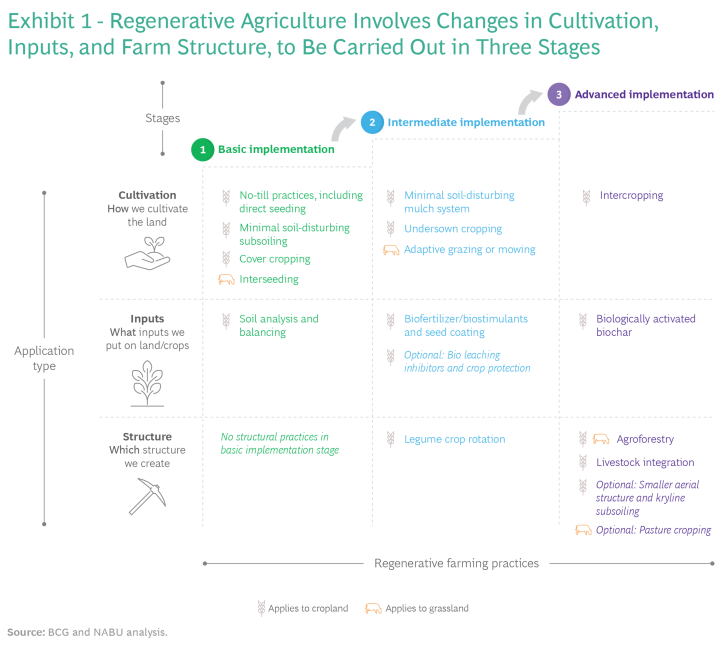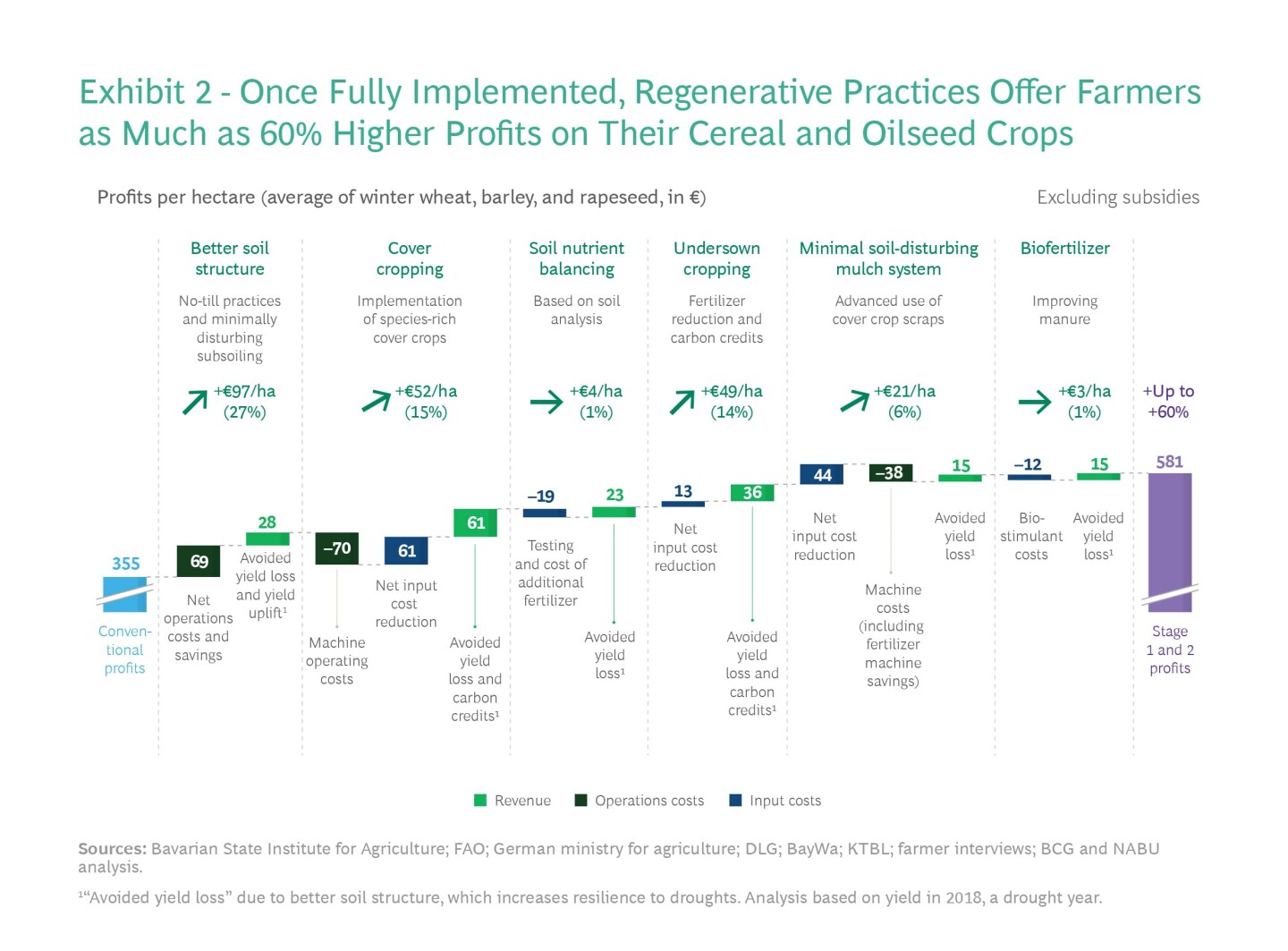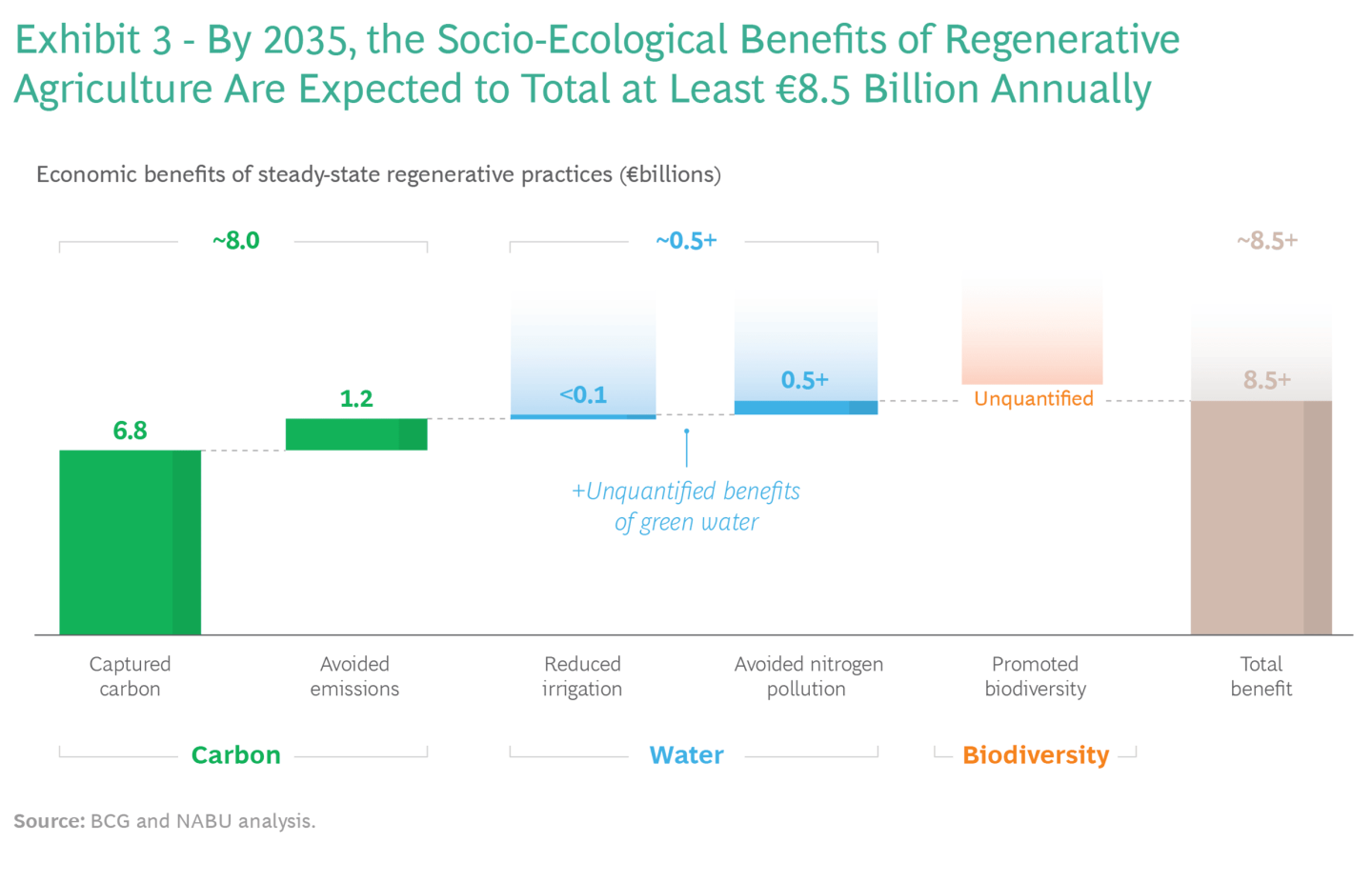In a world where the effects of global warming are on the rise and where pressure to mitigate them is growing rapidly, the global agri-food system faces a major problem.
It is, of course, vital to the survival of the world’s billions of people as a source of both food and livelihoods. But at the same time, its contribution to climate change and biodiversity loss is immense, and it is among the industries most affected by these ecological crises.
Regenerative agriculture, we argue, is the only approach to farming that can overcome the agriculture industry’s status quo by significantly reducing the industry’s negative environmental impact on our land and climate, increasing its positive impact, and economically benefiting the entire agri-food value chain—from farmers to food manufacturers to retailers to consumers.
In Germany, the economic, social, and regulatory pressure on the agriculture system is especially intense. Agriculture contributes 12.5% of the country’s total Scope 1 greenhouse gas (GHG) emissions, a combination of carbon dioxide, methane, and nitrous oxide from crops and livestock, as well as land use changes that lead directly to the release of GHGs from the soil. Farmers must cope with the increasing intensity and frequency of extreme weather events—both droughts and torrential rains—that wreak havoc on crops yields, even as they struggle to meet the increased cost of land and farming inputs. Meanwhile, regulators are imposing limits on GHG emissions and requiring changes in land use, and consumers are demanding healthier, cheaper food.
This article presents the key findings of our detailed analysis of the economic, environmental, and social benefits of regenerative agriculture in Germany—and by extension, in every country with a mature agri-food system.
What Regenerative Agriculture Is and Isn’t
Some people imagine that regenerative agriculture is an esoteric, dogmatic ideology, just “another trend” after organic farming. Others suppose that it is a kind of carbon farming, designed solely to manage GHG emissions at the expense of reducing farmers’ yields. Such perceptions are erroneous, however; in fact, regenerative agriculture is a collection of pragmatic farming practices that can be carried out beneficially on both conventional and organic farms. As we shall see, these practices leave farmers and food companies better off economically, and most negative short-term impacts that may occur are typically the result of uninformed trial and error.
Healthy soil is a key enabler for productive agriculture, and most regenerative practices are designed to support the soil’s functions by protecting and feeding its biodiversity. This is the goal of the three principles at the heart of regenerative agriculture: no-till farming, including direct seeding; permanent coverage of the soil with plants; and promotion of biological diversity, including wider crop rotation.
The essential practices of regenerative agriculture are meant to be implemented in three stages—basic, intermediate, and advanced—over the course of several years. (See Exhibit 1.) In general, each stage includes three kinds of activities that affect how soil and crops are cultivated, what inputs are used, and how the land is structured.

To establish a foundation for the best results, farmers should carry out all of the basic Stage 1 practices together, but the succeeding stages and their specific practices aren’t written in stone. Depending on context and past practices with regard to such variables as climate and soil type, individual farms may require different regenerative practices. Shifting to regenerative agriculture is a continuous process that requires time to thoroughly understand each farm’s circumstances. The key is to reflect, adapt, and regenerate.
Benefits for Farmers

Regenerative agriculture has long been associated with lower yields and shrinking profits for farmers. However, an objective analysis of the economics of German farms conducted on a per-hectare basis shows that regenerative agriculture offers huge benefits in the middle to long term, resulting in higher profits for the country’s farmers. Overall, once a steady state of implementation is in place—typically after 6 to 10 years—Stage 1 and Stage 2 practices should increase farmers’ profits by an estimated 60% or more.
An example of this analysis breaks down the specific practices carried out on a typical crop farm that grows cereals and oilseeds. (See Exhibit 2.) Improvements in soil structure as a result of no-till farming, for instance, would increase the farm’s profits by €97 per hectare, including a gain of €69 per hectare in net cost savings from avoided tillage operations and €28 per hectare in revenue from increased yields.
 Regenerative farming is vital to ensure food security
Regenerative farming is vital to ensure food security
Aside from the positive impact on farmers’ income, long-term improvements in the fertility of the soil increase farmland’s productive potential and thus have a positive effect on its value.
Undoubtedly some farmers lack the capital needed to cover the cost of adopting certain regenerative practices or may simply be unwilling to risk abandoning their customary approach to farming. To overcome these fears, Germany’s government and its food companies must support farmers in their transformation toward regenerative agriculture and convince them that they can achieve positive economic effects even in the first year of the transition.
Socio-Ecological Benefits
Shifting to regenerative agriculture would also have substantial benefits for German society overall, improving the quality of the country’s environment on several fronts and enhancing the nutritional value of the country’s food.

Our analysis shows that the socio-ecological benefits of regenerative agriculture in Germany could have a total economic value of approximately €8.5 billion per year. (See Exhibit 3.) Around €8 billion of this amount would come from regenerative agriculture’s positive impact on the country’s carbon footprint. Strengthening the soil’s capacity to serve as a carbon sink would account for about €6.8 billion of the €8 billion, and reducing GHG emissions—primarily nitrous oxide and methane, two especially potent greenhouse gases—would account for another €1.2 billion.
In addition, an estimated €0.5 billion in annual benefits would result from improved water quality, achieved by reducing the need for irrigation and by avoiding nitrate pollution attributable to excessive use of nitrogen fertilizer. Further benefits would arise from improvements in the country’s water cycle—the process of terrestrial precipitation, evaporation, and soil moisture (“green water”)— due to the upgraded condition of the soil, but quantifying these gains requires more research.
Another key goal of regenerative agriculture is to protect existing biodiversity by reducing the negative impacts of conventional agriculture, and to increase the overall biodiversity of cropland and grassland. Although our analysis does not attempt to quantify these benefits, they are driven primarily by improved soil health and reduced use of synthetic crop protection and fertilizer inputs.
Benefits for the German Agri-Food Value Chain
A primary effect of regenerative agriculture is resilience—the ability of soil, crops, and the local ecosystem to better handle climate-related shocks to the system. This effect underpins a key benefit for Germany’s agri-food system: the safeguarding of future supplies of food and food inputs.
Lower crop yields due to extreme weather could reduce companies’ access to the input crops needed for the food they produce, putting their operations and production volumes at risk. And the price they must pay for input crops could increase, especially in years with low yields, putting pressure either on their profits or on consumer prices. By strengthening farmers’ resilience in the face of severe weather conditions, regenerative agriculture can help companies secure stable sources of input crops. Our analysis shows that regenerative practices can reduce yield losses in years marked by severe weather conditions by up to 50%.
A further benefit involves ensuring food companies’ reputations and social license to operate. Investors, regulators, and consumers are pressuring companies in every industry to lower their GHG emissions and implement greener, more environmentally friendly practices throughout their operations. Companies in the downstream food value chain have a particularly onerous obligation to meet their green goals—in particular, those related to Scope 3 emissions—given the sheer size of their impact on the environment and their role in supplying food to Germany. By supporting the goals of regenerative agriculture, they can enhance their reputations as environmentally friendly companies and ensure that they stay in front of current and future environmental and climate regulations.
Taking all of these benefits into account, regenerative agriculture promises a triple-win for farmers, society, and the food industry.
The Way Forward
Despite the many benefits of regenerative agriculture, the transition won’t be easy to accomplish. It’s difficult to convince farmers to embrace a fundamentally different approach to farming without broad and centrally organized support, and fears of reduced yields and higher costs remain a challenge for them and for the food companies they supply.
Promoting regenerative agriculture will therefore require a concerted effort by all stakeholders in Germany’s food supply, including agriculture input companies, academic experts, agronomic advisors, regulators, and downstream food producers, distributors, and retailers.
The return on investment of regenerative practices is high, not just for Germany’s farmers, but also for the companies that make, distribute, and sell food—and especially for the country’s consumers and society at large, which will benefit from a healthier, more sustainable, and more secure food supply. It’s a triple-win for all concerned.















